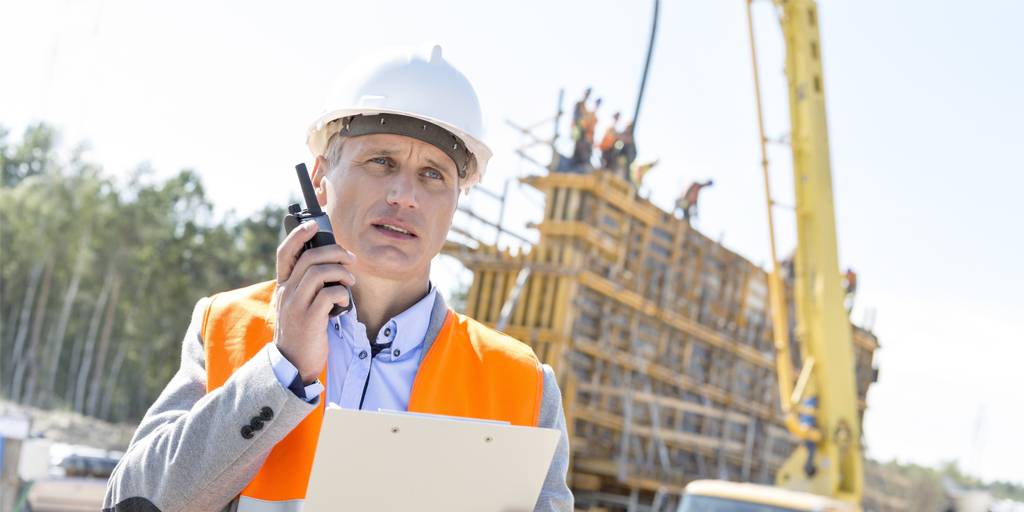When it comes to high-risk work like construction and manufacturing, crises are bound to arise. Employees can find themselves in hazardous situations with no easy means of communicating their peril to other workers.
In warehouses or large jobsites, this can be especially dangerous as some workers might find themselves facing an emergency situation without a nearby point-of-contact. That’s why it’s essential construction managers implement an effective safety communication protocol.
Ensuring a streamlined communication protocol is in place during emergencies can make sure all employees stay informed and prepared for when disaster strikes – be it an injury, natural disaster, or other unexpected event.
Equip Employees With Radios
Most construction managers equip their employees with some sort of portable mobile device. Often, this device is a cellphone. While cellphones are effective for standard communication, they don’t deliver the immediacy needed in emergency situations.
Whether you’re caught in an emergency or trying to warn others of impending danger, dealing with dial tones and voicemail can cost you valuable minutes. Two-way radios are the best way to communicate in an emergency situation, as they allow a direct line to other workers who need to be aware of the matter at hand.
Furthermore, many two-way radios come with valuable emergency features, including:
- Man Down: This feature allows some two-way radios to detect when there is a lack of movement or when the radio is in a horizontal position, thus suggesting a worker has collapsed. It activates a “chirp” sound which will notify nearby radios that something is wrong.
- Lone Worker: This is ideal for the aforementioned scenario in which many workers find themselves without nearby human contact. If they don’t use or touch their radio for a substantial amount of time, a signal will trigger predesignated radio operators of a potential SOS and need for check-in.
- Emergency Alert Button: This allows workers in emergency situations to send out a network-wide alert with the push of a button. This is useful in situations where there may be fire, suspicious figures on the jobsite, or a visible incoming natural disaster (such as a tornado on an oil field).
Implement a PA System
In situations where the jobsite is more contained, a PA system may be the more effective route for announcing emergencies. This allows operators and managers to send a mass announcement to workers on the jobsite of a potential danger.
Many PA systems have as wide as a two-mile reach, making them functional for even outdoor jobsites. It is important to limit PA system access to appropriate departments, such as management or HR, so as to avoid false alarms.
Emphasize the Buddy System
The “buddy system” may sound like something you haven’t used since fifth grade field trips, but it’s immensely crucial to communicating in an emergency situation. On hazardous worksites, workers that have to take on high-risk tasks should be encouraged to pursue them with a partner.
Having a partner is essential in the event one worker faces an emergency, as that partner can return to management and relay the situation. While technology allows for expedited assurance of safety, face-to-face communication is still the clearest form.
Dispatch Informers & Messengers
Certain individuals should act as predetermined informers and messengers in the event of an emergency. These are reliable workers that can deliver news calmly and concisely to other workers, so as not to alarm them.
Informers should also be encouraged to give as much information to the workers as possible about the emergency situation. Often, not having the complete story can create even further panic. It helps to prepare informers with HR training, so they know how to steadily convey bad news.
Consider Wearable GPS Devices
Wearable GPS devices can be clipped to the wrist or hip. They’re unobtrusive, allowing employees to smoothly continue their work without interference, and they allow managers to keep track of their employees’ whereabouts.
This is helpful on larger jobsites, especially in the event they’ve received an alert from the employee’s radio. It allows managers and emergency services to swiftly locate the employee in danger, thus reducing the risk of a more detrimental outcome.
Ellie Batchiyska is a writer for Discount Two-Way Radio, a leading two-way radio provider for the construction, warehousing, and manufacturing industries.
